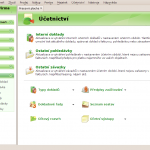Flexibee accounting package
 One of the few things I really do miss in Linux environment is a proper accounting software.
One of the few things I really do miss in Linux environment is a proper accounting software.
About a year ago, I managed to convince a friend of mine who owns this local store to try Linux on his office computer. He took to the idea gladly because the computer in his office was used by many various users, his father, part-time workers etc. Every one of them installed an icq toolbar here, a small application there and as a result, we had to re-install Windows quite often since the computer was constantly overloaded with unnecessary applications, spyware and viruses. Yes, we could have set up a Windows account with more restrictive rules, but Linux simply seemed a safer choice. At first I was worried about how people who don’t know much about computers, people who use computers just for browsing, e-mails or editing excel documents would react to a completely different operating system.
The good news was that as long as all they needed was to browse, read e-mails or edit excel documents, everything was fine. Linux offers excellent tools for running the usual office agenda. I just had to set up those tools and a few other things like access to online banking application, all things that they wouldn’t have been able to do themselves, but once everything was up and running, there’s been no major trouble for nearly a year now. Most importantly, they never wanted to switch back to Windows. Instead of the regular re-installations, I simply log in remotely now and then to check if everything’s fine and to upgrade software.
Now, switching an office machine to Linux was relatively easy. This summer, we’re planning to find a solution for the computer that serves at the cash desk and holds an accounting package with all stock items. Currently, there’s an antique MS-DOS accounting programme running on a Pentium I. Of course, I can’t comment on the qualities of accounting packages from the book-keeping point of view, but it’s obvious that if we want to employ barcode readers, synchronize stock with an online e-commerce solution via XML or use other up-to-date features, we just have to find another accounting package.
With one successful switch of the office computer, I began to wonder if we could use Linux on the other computer, too. The major problem is ERP, of course. I started looking around and the only Czech accounting package for Linux that looked promising was Winstrom, or Flexibee ![]() – its new name from 2010 on.
– its new name from 2010 on.
Expectations
As I’ve said, I’m not an accountant so I can’t make a thorough review of the accounting qualities, I’ll have to leave this to the people who actually use these programmes, but I’ve got a pretty clear idea about the technical requirements the package should meet – to communicate with a shopping cart solution. To be more specific:
- retrieve the list of users from the e-commerce programme and import it to the ERP (add new users and update the existing ones)
- send the list of users from the ERP to the e-commerce programme and apply changes previously made in the ERP
- export and send the stock structure to the e-commerce solution and add new categories or update the existing category tree
- export and send the list of stock items, add new items or update the existing ones, including name, price, amount of items currently on stock, etc.
- retrieve a list of new orders made on the e-commerce site and import it to the ERP
- all this should be done preferably via the XML format
I was able to put these explicit requirements together because I had been working on a e-commerce solution synchronized with an accounting package called Pohoda ![]() just a couple of months ago. This project was based of an accounting software running on Windows, however. I was responsible for the shopping cart solution and parsing of XML, while a colleague of mine did a small Windows desktop application that was able to run an XML export feature of the accounting programme and send the result to an ftp server, as well as download another XML file from the server and run the XML import function of the package. This had to be done by a user on a Windows workstation, it was only one click, but it was a click nevertheless.
just a couple of months ago. This project was based of an accounting software running on Windows, however. I was responsible for the shopping cart solution and parsing of XML, while a colleague of mine did a small Windows desktop application that was able to run an XML export feature of the accounting programme and send the result to an ftp server, as well as download another XML file from the server and run the XML import function of the package. This had to be done by a user on a Windows workstation, it was only one click, but it was a click nevertheless.
What I like about searching for a Linux solution is a possibility of full automatization. I believe the same goal can be reached in the Windows environment, too, but Linux offers tools like CRON that I like and that seem best fit for the job.
Flexibee
 Having described the situation, I’m finally getting to the very accounting package. Flexibee is available for download and you can use the programme and all the features for as long as you want, the only limitation here is number of items in lists like invoices, orders, contacts, etc. So if you are just a small business, you can legally use the package for unlimited period of time.
Having described the situation, I’m finally getting to the very accounting package. Flexibee is available for download and you can use the programme and all the features for as long as you want, the only limitation here is number of items in lists like invoices, orders, contacts, etc. So if you are just a small business, you can legally use the package for unlimited period of time.
The first impression after the installation was quite good, the interface is smooth and user-friendly. But I had to ask someone else, too. I met an account I know and we spent some time over the programme together. I was disappointed to find out that she didn’t find the package appealing, but I didn’t want to give it up right away, it had been a long day and I also wan’t sure if she didn’t like the programme because it didn’t meet some factual accounting standards, or because she was using a different package at work and simply didn’t have enough patience to get used to an unfamiliar interface layout.
 The next stage of testing came when I decided to use the package for my own small business. Until now, I was issuing invoices simply by writing them in Open Office Calc (excel) editor. The free version of Flexibee with limited number of issued orders was enough for me to start with. And if I like it, price of the basic commercial version is very affordable so I can buy it any time.
The next stage of testing came when I decided to use the package for my own small business. Until now, I was issuing invoices simply by writing them in Open Office Calc (excel) editor. The free version of Flexibee with limited number of issued orders was enough for me to start with. And if I like it, price of the basic commercial version is very affordable so I can buy it any time.
Again, I’m no book-keeper, all I need is to issue and receive invoices, pair them with bank account transfers and also keep track of cash transactions. It posed no big problem to find out how to perform these simple operations. Also, I don’t need such a sophisticated e-commerce to ERP bridge with all the features I’ve described above. I need to receive orders generated by an e-commerce programme and import them to the accounting package, which is possible with help of XML import feature, which is present in both free and basic version of Flexibee.
The thing I liked the best was that one installation may serve as a server where all data is stored, and other installation may connect to the data source remotely, even the basic version of the package. This exactly suits my needs, I can put the main installation on a computer in the office, where fast 100/100 Mbit broadband connection is available, have another installation on a laptop as I travel often, and yet another installation in the store where goods is actually sold. You can have as many installations as you want, the licence you buy only limits the number of users simultaneously connected to the data source. In my case, that would be two licences, me connected either in the office or remotely, and the computer at the store. If I was considering Pohoda, a well-established competitor accounting package, I wouldn’t be able to use the basic version because it doesn’t support remote connections, in addition I would have to buy two or three Windows licences and the final costs would be roughly tenfold.
This was me, pretty easy, no tough decisions – it’s cheaper, windows-free. Now, back to the friend of mine who runs his, much bigger store. I needed additional information so I signed up for a Flexibee presentation which is run every month or so for possible customers. I think it’s good they do these presentations, at least I did welcome it.
Here I learned that if I wanted to connect the ERP and e-commerce, there are two options. Either you can manually import / export XML files, which is feasible if there are only a few. The other way is to use API. The good news is that API for reading is very simple to use, so it’s no problem to get data from ERP to a server periodically, fully automaticaly and with no middleware agent that would be dependant on user, which means there’s less risk something goes wrong. The bad news is that API for writing has to be bought separately and is rather expensive. What I also understood from the comparison with Pohoda and from the presentation is that the package is still being developed and new features are added basically every month. Which is probably no problem for me and my small business requirements, but has to be considered in the case of my friend who runs a medium-size store.
To be continued
Well, this is where I got so far. Flexibee seems very promising and I’m definitely going to keep it for my small business.
The question is if I should use it at my friend’s store, or if it would be more reasonable to use well-established software Pohoda. The prices of the standard versions of both packages are comparable, but if you need Flexibee with read and write API, the price goes up considerably. On the other hand, the read and write API eliminates a need of using middleware and makes the whole process of synchronization with e-commerce solution fully automatical. We would also save money for Windows licences. We also have to consider barcode reader hardware support or the fact that Flexibee is still being rapidly developed.
I’ll have to take all this into consideration and make a decision in the following weeks. I will finish this post when I’ve done so.
Leave a Reply
You must be logged in to post a comment.